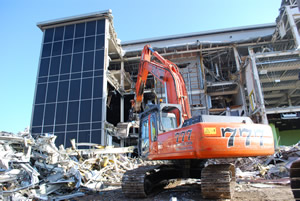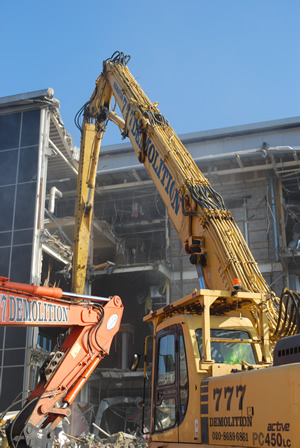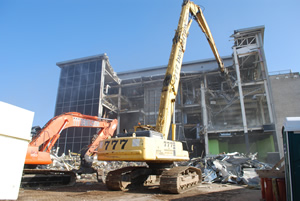IMAX Cinema, Bournemouth



Project Summary
| Client: | Interserve Construction |
| Sector: | Leisure |
| Location: | Bournemouth, Dorset |
| QS: | Sweett Group |
| Contract Value: | £0.4m |
| No. of Units: | N/A |
| No. of Floors: | 4 |
| Demo Period: | 16 Weeks |
| Completion Date: | April 2013 |
Demolition and dismantling specialist 777 Group has recently completed the demolition of Britain’s most despised building - the IMAX complex in Bournemouth.
Located on the town’s sea front, the building drew intense criticism when following its completion in 1998, predominantly for obscuring views across the water towards the Purbeck Hills. The complex included a multi-screen cinema although this opened 2 years after building work finished and closed unexpectedly in 2001. The facility then lay dormant until Bournemouth Council announced its intention to purchase the site, demolish the building and create a new outdoor events space for music and arts.
The demolition project spanned 4 months with 777 Group spending the final 6 weeks of 2012 securing the site, soft stripping the building’s internal fixtures and fittings and removing waste material. Up to 30 trained demolition labourers were deployed on the project during these initial stages, most of whom were tasked with extracting and separating 900 tonnes of rubbish found languishing in the basement. Once internally stripped, the building was prepared for demolition by inserting steel support frames in the basement which ensured heavy-duty plant and equipment could operate at ground floor level during the demolition without any risk that it may give-way.
Challenges
The beginning of 2013 witnessed the arrival of 777 Group’s giant high-reach demolition rig and the start of demolition proceedings, much to the approval of local residents who gathered nearby to witness the structure’s demise. Weighing 45 tonnes and capable of reaching a height of 22 metres, the company’s two Komatsu PC450 machines utilised a multiprocessor demolition attachments at the end of its three-piece arms to cut and crush the complex’s steel and concrete structure.
Initially the building’s main entrance was dispatched with the remaining structure demolished in four separate stages. All deconstruction work took place inside the site’s original perimeter. Felled material was separated and stockpiled by a 30 tonne excavator equipped with a rotating grab attachment. In all some 13,500 tonnes of waste was separated and removed from the site with 3000 tonnes and steel and 8000 tonnes of concrete successfully recycled.
777 Group’s contracts manager, David Wilcott explains further, “The site was very small and as a result there was not a great deal of room to sort or store waste material. However, by carefully planning the process of deconstruction we were able to safely demolish the building and ensure material was segregated in a timely and efficient fashion. Recycling rates exceeded ninety seven percent despite the restrictive nature of the site”.
Because the project’s high profile was matched by a great deal of interest from members of the public, site security was paramount. As a result the site was ring-fenced by secure hoarding with manned access points. A team of demolition operatives were also deployed to temporarily seal adjacent footpaths during specific phases of the demolition ensuring onlookers remained at a safe distance.
With 777 Group fulfilling one of the most iconic tasks associated with redeveloping this controversial site, the rapid and safe restoration of some of Bournemouth’s best vistas has now been returned for both residents and visitors alike to enjoy.



